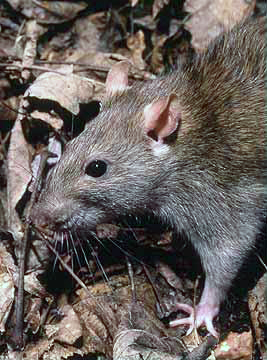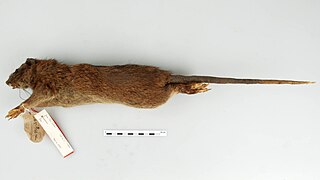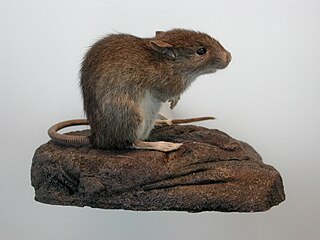
Rattus is a genus of muroid rodents, all typically called rats. However, the term rat can also be applied to rodent species outside of this genus.

The Flores giant rat is a rodent of the family Muridae that occurs on the island of Flores in Indonesia. It has been recorded in Rutong Protection Forest. The species is found in primary, secondary and disturbed forest over a wide range of elevations. Its head and body length is 41–45 cm (16–17.5 in) and its tail length is 33–70 cm (13–27.5 in). These dimensions are about twice as large as those of a typical brown rat, which suggests about eight times the body mass.
The squirrel-toothed rat, also known as the New Guinea giant rat, powerful-toothed rat, uneven-toothed rat, or narrow-toothed giant rat, is a species of rodent in the family Muridae. It is the only species in the genus Anisomys and is found in New Guinea.
The West African shaggy rat is a species of rodent in the family Muridae. It is found in Benin, Cameroon, Ivory Coast, Gambia, Ghana, Guinea, Guinea-Bissau, Liberia, Mali, Nigeria, Senegal, Sierra Leone, and Togo. Its natural habitats are subtropical or tropical seasonally wet or flooded lowland grassland and swamps. It is a common species and the International Union for Conservation of Nature has rated its conservation status as being of "least concern".
Lorentz's mosaic-tailed rat is a species of rodent in the family Muridae. It is found in West Papua, Indonesia and Papua New Guinea. The rat is named after Hendrikus Albertus Lorentz, a Dutch explorer who passed through Lorentz National Park on his 1909–10 expedition.
The Giluwe rat is a species of rodent in the family Muridae. It is found only in Papua New Guinea, on Mount Giluwe and the subalpine grasslands of the Kaijende Highlands.
The Japen rat is a species of rodent in the family Muridae found only in Yapen, Biak-Supiori, and Owi islands of West Papua, Indonesia.
The Cape York rat is a species of rodent in the family Muridae. It is found in southern New Guinea, in both Indonesia and Papua New Guinea, and in Cape York Peninsula in Australia.
The eastern rat is a species of rodent in the family Muridae.

The Himalayan field rat, sometimes known as the white-footed Indo-Chinese rat, is a species of rodent in the family Muridae. It has a wide range, being found in India, Bangladesh, Nepal, Bhutan, China, Myanmar, Laos, Thailand, and Vietnam, with introduced populations in Indonesia (widely), Palau, and the Philippines. A common species, the International Union for Conservation of Nature has assessed its conservation status as being of "least concern".

The New Guinean rat is a species of rodent in the family Muridae. It is found only in parts of central Papua New Guinea.
The large New Guinea spiny rat is a species of rodent in the family Muridae. It is found in Indonesia, Papua New Guinea, and the Solomon Islands.
The dusky field rat, also known as the canefield rat, is a species of rodent in the family Muridae. It is found in Australia, Indonesia, and Papua New Guinea. In Australia it is found in northern Queensland and along the east coast as far south as Shoalwater Bay, where it is plentiful, and on South West Island in the Sir Edward Pellew Group off the Northern Territory, where it is considered a threatened species.
Stein's rat, also known as the small spiny rat, is a species of rodent in the family Muridae. It is found in West Papua, Indonesia and Papua New Guinea.
The moss-forest rat is a species of rodent in the family Muridae. It is found in Indonesia and Papua New Guinea.
The glacier rat is a species of rodent in the family Muridae. It is endemic to the New Guinea Highlands near Puncak Trikora and Puncak Jaya, West Papua, Indonesia. Its altitudinal range is 3,225–4,500 m (10,581–14,764 ft) above sea level.
Van Deusen's rat is a species of rodent in the family Muridae. It is endemic to the mountains of southeast Papua New Guinea.
The slender rat is a species of rodent in the family Muridae. It is found in West Papua, Indonesia and Papua New Guinea.
The southeastern xanthurus rat, is a rodent of the genus Rattus.
The Vogelkop mountain rat, Rattus arfakiensis, is a species of rat native to Indonesia. It is found only in the Bird's Head Peninsula of Papua Province, Indonesia.




